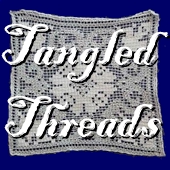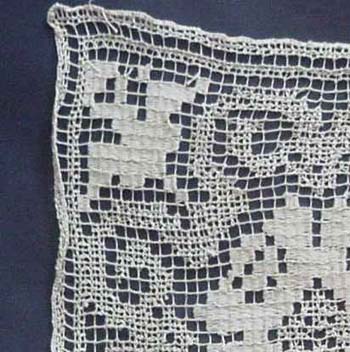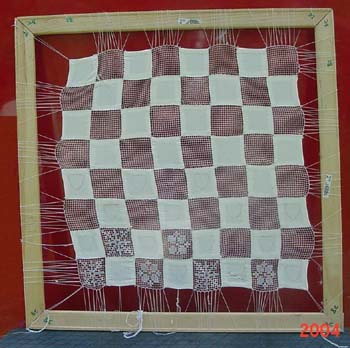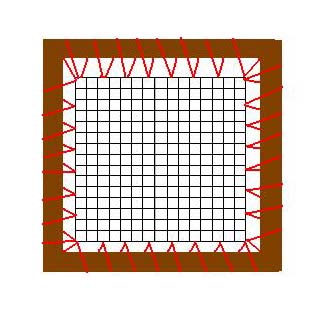
 



|
 Stretching Stretching
Stretching your netting fulfills the same purpose as
putting cloth into an embroidery frame: it stabilizes the
mesh and draws it taut enough to be easily worked upon.
Most books I have encountered recommend fitting
the mesh into a frame that exactly matches the finished
size and shape of your lace. that's a laudable ideal, I'm
sure, and I've done it from time to time. But it can get
to be expensive and unwieldy, particularly if you are
working a large volume of lace.
So what is a cost conscious crafter to do? Same as
always: improvise. My first stretching frame was actually
a piece of cloth stretched tight in a lap-quilting hoop.
I sewed my mesh down, and then cut away the cloth
underneath. It worked very well, though I ran through all
my scrap cloth in very short order.
For smaller projects, a heavy wire coat hanger can be
bent into the proper shape, and serves very well. However
it's not as suitable for larger pieces, as the wire wants
to bend under tension. Simply tacking or pinning a mesh
to a board or pillow has worked for me in the past, but
is not my favorite way of working; it is awkward to sew
with wood or cloth under the mesh.
An embroidery scroll-frame is ideal for most small
projects, and is particularly good for long pieces, such
as edgings and ruffs and such. It's even possible to work
larger projects on one: simply replace the regular
scrolls with longer dowels.
 My current
favorite frame, however, are canvas stretchers. These are
wooden pieces (four of them to make a square) of picture
frames that painters use to prepare and mount canvasses
before painting. They are relatively cheap (between $2
and $20 for a set of four, in any good art supply shop),
easy to store, -- since they are modular -- and come in a
variety of sizes (ranging between 6 and 48 inches). Since
they are modular, they can be mixed and matched to
achieve the best size and shape for your project. My current
favorite frame, however, are canvas stretchers. These are
wooden pieces (four of them to make a square) of picture
frames that painters use to prepare and mount canvasses
before painting. They are relatively cheap (between $2
and $20 for a set of four, in any good art supply shop),
easy to store, -- since they are modular -- and come in a
variety of sizes (ranging between 6 and 48 inches). Since
they are modular, they can be mixed and matched to
achieve the best size and shape for your project.
The frame I would most certainly NOT recommend is an
embroidery hoop (including those new PVC ones). with a
very few exceptions, it just doesn't work. The hoop ends
up distorting the mesh around the outside, breaking
threads, and generally spoiling your work.
 Regardless of
which frame you choose, the process of stretching is
essentially the same. The mesh is sewn into place, with a
sturdy thread looping between the frame and the edges of
the mesh, such as is illustrated in the diagram. As you
take up the slack, care should be taken to be sure the
lace maintains proper shape and isn't distorted. If you
are working with square mesh, you might want to take two
loops in the corners, to help to pull them square. Regardless of
which frame you choose, the process of stretching is
essentially the same. The mesh is sewn into place, with a
sturdy thread looping between the frame and the edges of
the mesh, such as is illustrated in the diagram. As you
take up the slack, care should be taken to be sure the
lace maintains proper shape and isn't distorted. If you
are working with square mesh, you might want to take two
loops in the corners, to help to pull them square.
But don't fear about breaking the mesh; it's surprisingly
strong, and can tolerate more tension than you might
suppose. With a strong cotton-thread mesh, I can draw my
own work as tight as a drumhead, without fear of breaking
any thread. You don't really want it that tight; a very
little slack will make darning easier But it is possible,
as the mesh is stronger as a whole than it might seem.
[The
information and images on this website are Copyright of
Lady Cecilia Bartoletti (June). You may make a copy and
use any information contained herein for personal use
only, or for SCA documentation purposes. Unauthorised
publication is not permitted.]

|